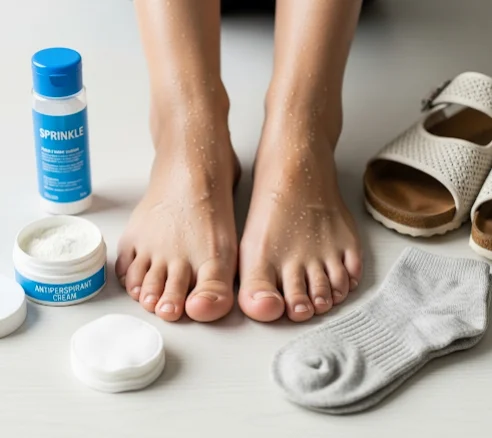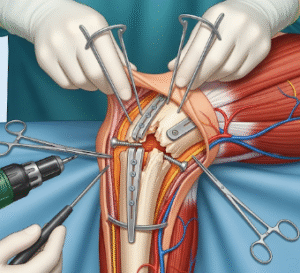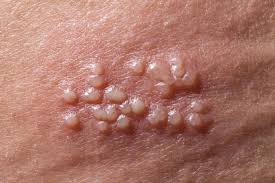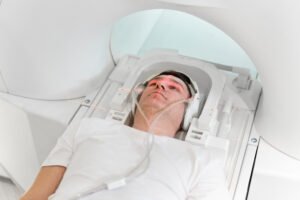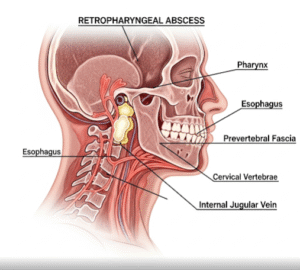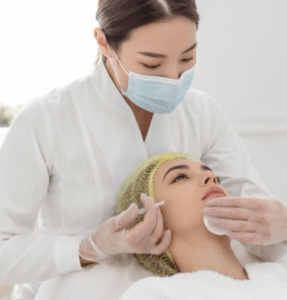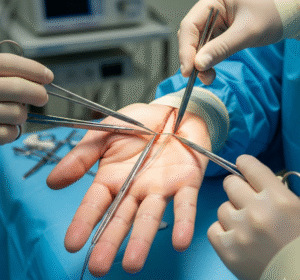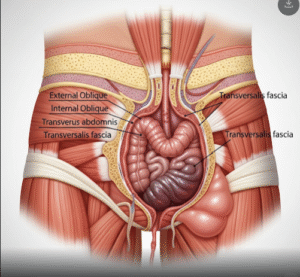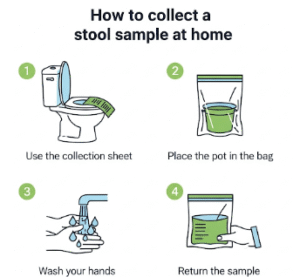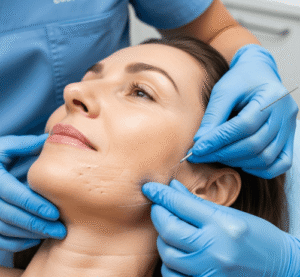What it is
Plantar hyperhidrosis is a condition where the sweat glands in the soles of the feet are overactive, leading to excessive and uncontrollable sweating. Unlike normal sweating, which regulates body temperature, this type happens even at rest and in cool environments.
It often coexists with palmar hyperhidrosis (sweaty hands). While not dangerous, it can cause:
- Odor issues due to bacterial/fungal overgrowth
- Skin irritation, blisters, or athlete’s foot
- Difficulty wearing shoes or socks
- Embarrassment in social/professional settings
💡 In Korea, where personal hygiene and aesthetics are important, plantar hyperhidrosis is treated with a mix of dermatological, technological, and lifestyle-based approaches.
Why it’s done
Plantar hyperhidrosis care is essential for daily comfort, hygiene, and confidence.
✔ To prevent foot odor and fungal infections (very common with sweaty feet)
✔ To improve comfort in shoes and socks
✔ To reduce skin damage like cracks, blisters, and maceration
✔ To enhance confidence in social situations (e.g., removing shoes indoors, common in Korea)
✔ To improve sports and daily activity performance, since slippery feet can impair balance and grip
Alternatives
Some alternatives may help manage plantar hyperhidrosis before seeking advanced care:
➡️ Topical antiperspirants – Aluminum chloride sprays or roll-ons for the soles.
➡️ Absorbent insoles and powders – Bamboo charcoal or medicated foot powders.
➡️ Breathable shoes and socks – Cotton, bamboo, or moisture-wicking fabrics.
➡️ Lifestyle changes – Avoiding caffeine/spicy foods, stress management.
➡️ Natural remedies – Foot soaks in tea, vinegar, or herbal infusions (common in Korean home care).
In Korea, daily routines often combine modern dermatology products with herbal foot soaks for odor and sweat control.
Preparation
Before beginning plantar hyperhidrosis treatment in Korea, patients typically go through:
- 🔹 Consultation with a dermatologist → Confirm diagnosis and rule out secondary hyperhidrosis (caused by thyroid or metabolic issues).
- 🔹 Starch-iodine test → Identifies sweat zones on the feet.
- 🔹 Medical history → Checking for fungal infections, skin conditions, or systemic illnesses.
- 🔹 Pre-treatment care → Patients are asked to keep feet clean and avoid lotions before evaluation.
How it’s Done
Plantar hyperhidrosis care in Korea involves different treatment options, tailored by severity:
- Topical Treatments
- Prescription-strength aluminum chloride creams or sprays.
- Medicated foot wipes with anticholinergic agents.
- Iontophoresis Therapy
- Feet are placed in shallow trays filled with water.
- A mild electrical current passes through, blocking sweat gland activity.
- Sessions last 20–30 minutes, 2–3 times weekly, then reduced for maintenance.
- Widely available in Korean dermatology clinics and as at-home devices.
- Botox (Botulinum Toxin) Injections
- Effective for severe plantar hyperhidrosis.
- Botox blocks nerve signals that activate sweat glands.
- Results last 4–6 months.
- Injections may be painful; Korean clinics often use nerve blocks or anesthesia.
- Oral Medications
- Anticholinergics (e.g., oxybutynin) may be prescribed for widespread sweating.
- Used cautiously due to systemic side effects.
- Laser or Microwave Therapy (MiraDry for feet – limited)
- Still experimental for plantar areas, but some clinics adapt energy devices for sweat control.
- Surgical Option: Endoscopic Lumbar Sympathectomy (ELS)
- For severe, resistant cases.
- Involves cutting/clamping nerves that control foot sweating.
- Used sparingly due to risk of compensatory sweating elsewhere.
- Korean Holistic Add-ons
- Herbal foot soaks (mugwort, green tea, ginseng) for odor and mild sweat reduction.
- Cooling sprays and essences for daily refreshment.
- Korean foot spas (jjimjilbang programs) sometimes integrate herbal baths for supportive care.
Recovery
Recovery depends on the treatment:
➡️ Topicals – Immediate daily use, but must be reapplied often.
➡️ Iontophoresis – Minimal side effects; dryness may occur.
➡️ Botox injections – Temporary soreness, swelling, or difficulty walking for a few days.
➡️ Oral medications – May cause dry mouth or blurred vision.
➡️ Surgery (ELS) – Requires hospital recovery and carries higher risk of compensatory sweating.
💡 Korean clinics support recovery with moisturizing foot masks, herbal balms, and cooling gels to keep skin comfortable.
Complications
Although generally safe, treatments may have some side effects:
⚠ Possible risks include:
- Skin irritation from topicals
- Pain and temporary weakness after Botox in soles
- Skin dryness from iontophoresis
- Systemic side effects from oral medications
- Compensatory sweating after surgery
Korean dermatologists minimize these risks through precise diagnosis, non-invasive therapies, and staged treatment plans.
Treatment Options in Korea
Korea offers some of the most comprehensive and patient-friendly plantar hyperhidrosis care programs in the world.
🇰🇷 Popular Korean Options:
- Iontophoresis programs → affordable, safe, and widely available.
- Botox injections for soles → common among professionals and athletes.
- Oral medication support → prescribed when other treatments are insufficient.
- Endoscopic lumbar sympathectomy → performed in advanced hospitals for resistant cases.
- Korean wellness add-ons → herbal soaks, medicated powders, and daily K-beauty-style foot care.
✅ Final Thoughts
Plantar hyperhidrosis care in Korea combines advanced medical treatments (Botox, iontophoresis, surgery) with holistic Korean wellness practices (herbal soaks, foot masks, stress relief). By addressing both the physical and emotional impact of sweaty feet, Korean clinics provide patients with comprehensive, safe, and effective care.
For many, Korea’s approach ensures not only drier feet but also restored confidence, hygiene, and quality of life—especially in social settings where shoes are often removed.

